For years I have told myself that if I want to pretend to know anything about fishing I should at least once join a fishing vessel and see the real thing. What held me back for a long time, however, is that a typical Dutch beam trawler fishes day and night, in batches of 2-3 hours, for about five days. That is a lot of time to block in your agenda, and a brutal day rhythm.
Enter the flyshoot fishery. The flyshoot technique has been used by Dutch fishermen since the 1980s, but it really took off about ten years ago, when fuel prices were high and NGOs criticized the impact of beam trawlers on the bottom of the sea. Flyshooting is an attractive alternative to the beam trawl because it is more fuel efficient, more selective, and easier on the seafloor. For a landlubber like me a great advantage is that a typical flyshooter makes fishing trips of about two to three days, during which fishing takes place only by daylight. That is a lot easier to reserve in my agenda and I might even get a decent night’s sleep while on board!
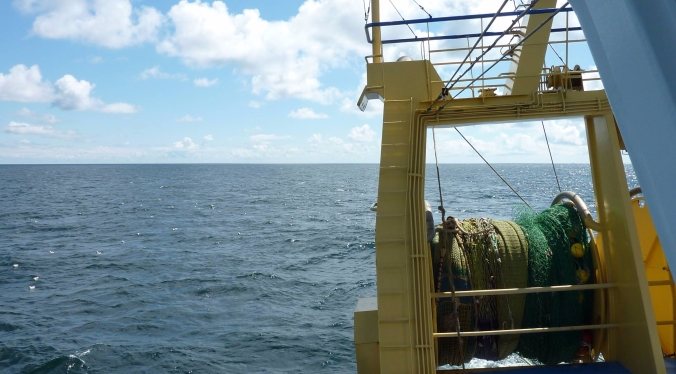
All aboard
So last Sunday evening I got on board the SL-9 Johanna, together with Arie Mol of Wageningen Economic Research and Marnix (the skipper), Sandy (the engineer), William (the cook), Colin and Toon. For Arie it was a fishing trip down memory lane: as a teenager he spent many a week on a small cutter. For me it was a whole new world. For the crew, of course, it was just another working week.
To understand the feeling leaving the port of Scheveningen you need to realize that coming from Wassenaar, I have looked out over this part of the North Sea countless times. I’ve flown over it on vacations or work trips, spotting ships and offshore wind parks. I have never, however, actually been on it. To go past the Scheveningen port lights, the motor humming and the occasional seagull calling, and to feel the calm water turn into a steady swell, was a magical moment.
Sleeping in a cutter is like sleeping in a light version of a rollercoaster. As the ship climbs up and rolls down the waves, you feel yourself floating in the air, pressed into your pillow, or rolled over. When I got up after an uneasy night it turned out the crew was already sorting out its second haul – in summer a flyshooter’s day starts early.

Flyshooting
Before he joined the SL-9 crew, Marnix had worked on a beam trawling vessel. Flyshooting is a very different way of fishing, he tells me, much more complicated than beam trawling. A flyshooting set starts with the unloading of the end of the first of two ropes, with two pairs of buoys attached to it. One pair could easily be mistaken for giant dinosaur eggs for their shape and size, if it weren’t for their bright orange hue: their job is plain and simply to be seen. The other two hold a piece of rope close to the surface so it can be picked up later on. Then the vessel draws one half of a diamond shape in the sea, releasing a rope of about three and a half kilometres. At the end of the first rope the crew unload the net, and draw the other half of the diamond shape with the second rope. When we near the end of the second rope we can see the orange dinosaur eggs in the distance. Now comes the most difficult part, Marnix says. The crew stand ready on the side of the boat to throw out a hook-and-line between the two small buoys. If one misses, another stands ready to give it a shot, but if he also misses, Marnix needs to set the boat in reverse, risking getting the rope entangled in the ship’s propeller. When the crew have caught the rope, the hauling of the net starts.
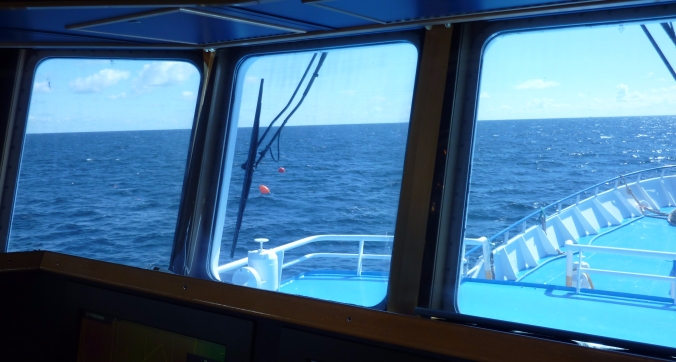
To understand the hauling of a flyshoot net, imagine a diamond-shaped square of about three square kilometres. That is slightly smaller than Central Park in New York, twice the centre of Utrecht, or, for that matter, most of Wageningen:
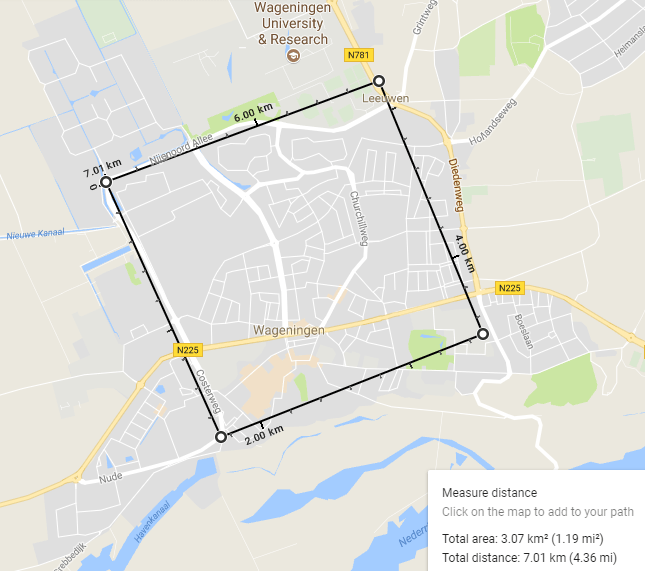
You are standing at one corner of the square, and in the opposite corner, about two and a half kilometre from you, there is a fishing net. Two ropes go from the fishing net to you, laid out along the borders of the square. As you haul in the rope, you will see that the net does not move immediately to you – first the two ropes will move to the centre of the square, driving all that can move and happens to be on the square to the area between you and the net. When finally the net starts moving towards you most of the fish within the square will be in the net’s path. Every time this big ball of fish is hauled in Marnix runs down to see for himself. It is like opening a Christmas present: what do we get this time?

Bycatch
Besides its fuel efficiency and its limited effects on the seafloor, a big advantage of flyshooting is that it is a very clean way of fishing. I could hardly see any starfish, brittle stars, of other not-so-mobile bottom dwellers in the catch that are much more abundant in that of beamtrawl vessels. The catch consisted mostly of fish species such as gurnard, mullet, whiting, dab, plaice, and mackerel, but, admittedly, also some shark and ray species. If only we could avoid those, as well as the whiting, the crew say. It is not a very valuable fish and it takes more work than gurnard and mullet as it needs to be stripped. But like all bottom fisheries, it is extremely difficult to pick the species you want.
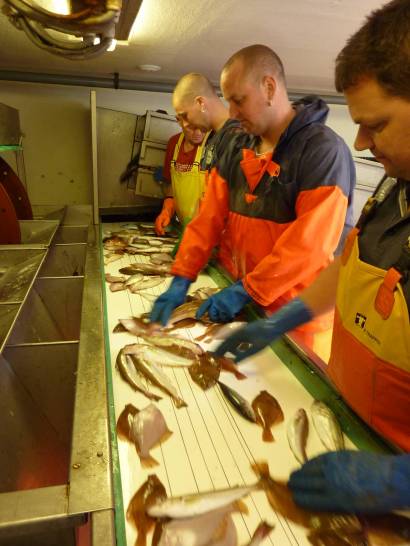
Therefore, the fishermen experience the landing obligation as a big thunder cloud hanging over their heads. I appreciate the need to reduce discards, or at least to improve its survival rate, but to me the landing obligation comes across as an unnecessarily blunt instrument. Flyshooting is one of the cleanest, most sustainable ways of fishing, but even they cannot cherry-pick their catch. The crew sorted out the catch four in a row; to meet the landing obligation would require one or two more crew members, and a lot of storage space for catch that will eventually be destroyed. If this is really going to be implemented, they said, I will stop fishing. We need to develop ways to address discarding, but this is not the way to do it.

Let’s see if we can squeeze in two more here
So long, and thanks
Travelling with the SL-9 has been a massive experience for me, and I want to thank the entire crew, Marnix, William, Sandy, Colin, and Toon for their hospitality. And thanks to Arie, for organizing this!
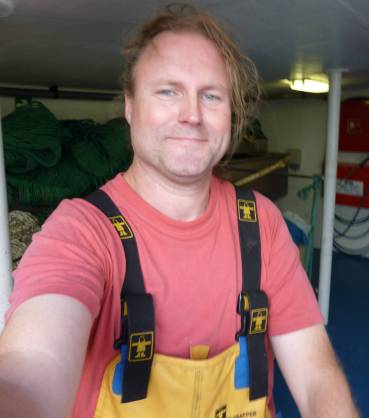
Dear Rolf, there is one thing I do not understand. There is not much bycatch of starfish and other slow movers. THere is by-catch of some sharks and rays. These have to be discarded but are probably still alive? Now what is the problem with the landing obligation for the fly shooters?
LikeLike
Dear Arjan, survival rates are still a matter of debate but for the most important flatfish those rates are in the order of 15%-30% (or at least that’s what Adriaan Rijnsdorp says in this TV programme: https://www.npo3.nl/deze-vissen-willen-wij-niet-eten). The landing obligation regards species for which there is a quota policy. For the flyshoot fishery this includes whiting and sole. See for more information https://www.visned.nl/thema/aanlandplicht and https://www.wur.nl/nl/show/QA-Europese-aanlandplicht-visserij.htm.
LikeLike